1. The first step of the struggle against colonial slavery, for national independence and national unification
After nearly three decades of waging an aggressive war, the French colonialists forced the Nguyen Dynasty to sign the H'Armand (1883) and Ptenôtre (1884) treaties, dividing Vietnam into three regions with three different governing regimes: Cochinchina was a colony, Annam was a protectorate, and Tonkin was a semi-protectorate; along with Laos and Cambodia, they were part of the French Indochina Federation.
Divide and conqueris one of the principles of French colonial rule. Vietnam was not considered a unified national state, without a government structure or a common parliament, even a sham. The mandarin apparatus of the Nguyen Dynasty was "autonomous" in some central provinces, but had no real power. The Governor-General of Indochina was represented by the French Government, below him were the Governor of Cochinchina, the Governor of Tonkin and the Residents in Annam, Laos and Cambodia. The Council of Cochinchina, the houses of representatives in Annam and Tonkin were established by the French colonialists to demonstrate the "democratic" nature of the colony.
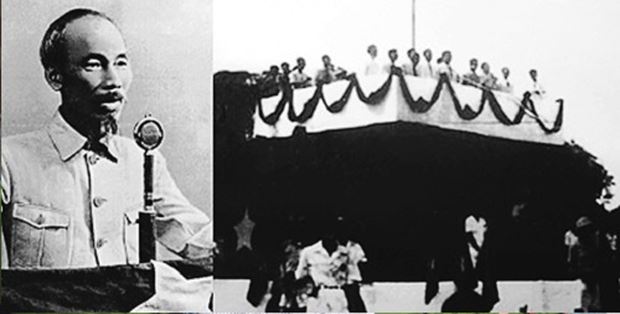
President Ho Chi Minh read the Declaration of Independence on the podium on the morning of September 2, 1945.
If in the French bourgeois revolution, the bourgeoisie abolished feudal separatism, unified the territory to form a national market, and created conditions for the development of a commodity economy, then in colonial Vietnam, they carried out the division of the territory and the division of the nation. They established "three different regimes in the Central, South, and North to prevent the unification of the country", "to prevent our people from uniting".[1].
The Vietnamese people's struggle against colonialism and for independence was also a struggle for national unity and territorial integrity. This struggle demanded the strength of national unity. Ho Chi Minh clearly stated: "Our history teaches us this lesson: Whenever our people are united as one, our country is independent and free. Conversely, whenever our people are not united, they are invaded by foreign powers."[2].
The purpose of the August Revolution was to "take back"peace, unity, independence and democracyfor our country, for our people"[3]. To do that, we must carry out great national unity. To do this, unify the forces and strength of the entire nation in the struggle for independence and freedom, the Viet Minh Front was born with member groups and associations named "national salvation", contributing to promoting the preparation of political forces, armed forces and building revolutionary bases.
When World War II ended and fascism was destroyed, seizing a once-in-a-thousand-years opportunity, the Party and the Viet Minh led the people in a general uprising, combining political and armed forces, integrating rural and urban areas, dismantling the government apparatus of the Japanese militarists and their collaborators, and establishing a unified national government throughout the country before the Allied forces entered Indochina. Thus, national independence and reunification were achieved through a revolution carried out by the Vietnamese people, not through the liberation of the Allied forces. The Allied forces' mission was to disarm the Japanese army, not to occupy and divide Vietnam, or to establish governments contrary to the will and aspirations of the Vietnamese people.
Before the French Government's unreasonable request for Vietnamese territory[4], inDeclaration of Independence(September 2, 1945), Ho Chi Minh declared "to completely break away from colonial relations with France, abolish all treaties that France signed on Vietnam". In a letter to the President of the United States, the President of the Government of the Democratic Republic of Vietnam stated: "When the Japanese were defeated in August 1945,The entire territory of Vietnam was unified under a Provisional Republican Government.And this government immediately went into operation within five months, peace and order were restored, a democratic republic was established on legal grounds, and it provided the Allies with adequate assistance in carrying out their disarmament mission.”[5].
The nationwide general election to elect the first National Assembly (January 6, 1946) fully demonstrated the will and aspirations of the Vietnamese people to build a unified and independent country. The official government elected by the Constituent Assembly (March 2, 1946) was "truly a government of the entire people". These actions were not only aimed at perfecting the State administrative apparatus, but also at institutionalizing the independence and unity of Vietnam.
2. Persistently pursuing the goal of national independence and national unification in the struggle against French colonialists' re-invasion of Vietnam
After World War II, many countries were divided, leading to the formation of two politically opposed states such as Germany, Korea, China and Vietnam. In the trend of détente, the great powers all advocated maintaining the status quo of world order, but the entire Vietnamese people remained united and steadfast in their struggle for an independent and unified nation.
The dawn of independence in Vietnam had not been long when the French colonialists returned to invade and continued to pursue the policy of dividing the country. After occupying Cochinchina and Buon Ma Thuot, they separated the South into the autonomous Cochinchina region and the highlands into the autonomous Tay Ky region (February 1946). Then they established the Cochinchina National Government with Nguyen Van Thinh as prime minister (March 1946). These were acts of sabotage against the standards of national unification of Vietnam. Therefore, the Vietnamese people must continue the struggle to "preserve and develop the victories of the August Revolution, that is,peace, unity, independence and democracy"[6]In the "critical" situation, the Party and Government have promoted the spirit of independence, self-reliance and creativity, organized and governed the country, carried out a struggle for self-reliance, and especially persistently used peaceful measures.
On March 6, 1946, the Preliminary Agreement was signed between the representative of the Government of the Democratic Republic of Vietnam and the representative of the French Government. Although they had not yet demanded recognition of independence from the French colonialists, they had to recognize the unity of Vietnam: Vietnam isa countryfree, with its own government, parliament, army and finances. The implementation of national unification will be decided by referendum.
Before leaving for France (June 1946), in a letter to the people of the South, the President of the Government affirmed: “The people of the South are the people of Vietnam. Rivers may dry up, mountains may erode, but that truth will never change!”[7]Ho Chi Minh's purpose in going to France was "to resolve the issue of Vietnam's independence and to unify the North, Central, and South regions."
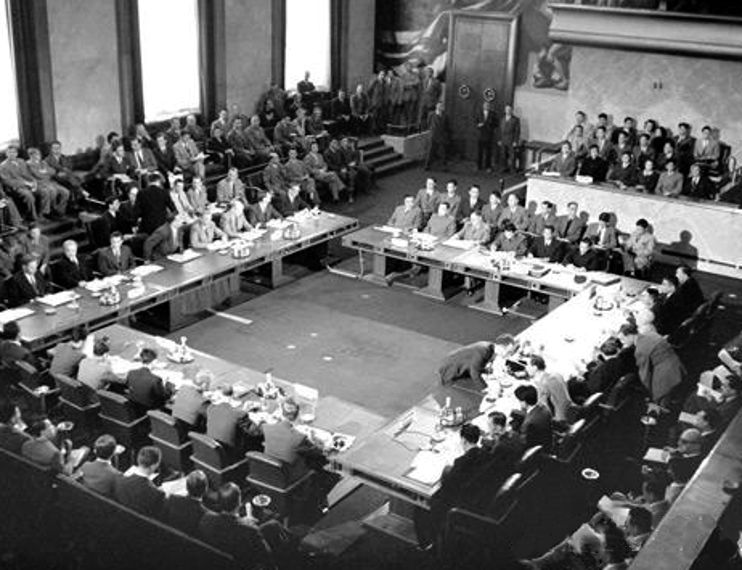
Scene of the 1954 Geneva Conference
In his speech at the National Day celebration of the Democratic Republic of Vietnam organized by the Overseas Vietnamese Association and the France-Vietnam Friendship Association in Paris (September 2, 1946), Ho Chi Minh stated: “The most earnest wish of all the Vietnamese people is that our resurrected Fatherland will never be divided and nothing can divide it”, “... division and separation cannot bring prosperity. It is absurd to attempt to rely on a weakened, divided and fragmented Vietnam to achieve the power of the French Union”.[8].
After returning from France, Ho Chi Minh declared to the nation: Due to the current situation in France, the two issues of independence and unification of Vietnam have not been resolved. “But sooner or later, I dare to decide that: Vietnam will definitely be independent, the North, Central, and South will definitely be unified.”[9]At the October 31, 1946 session of the Second Session of the First National Assembly, after being entrusted by the National Assembly with the responsibility of forming a new government, Ho Chi Minh declared the government's purpose as "internally, to build and develop, and externally, to strive for the independence and unification of the country."[10].
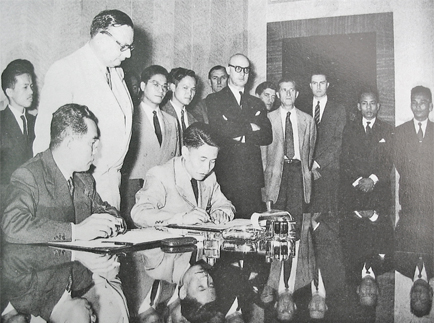
Comrade Ta Quang Buu, on behalf of the General Command, signed the 1954 Armistice Agreement.
In the Appeal to the United Nations (December 1946), Ho Chi Minh clearly pointed out the actions of France in "creating the Republic of Cochinchina with a puppet government" and affirmed that the Vietnamese people "resolutely fight to the end to protect the most sacred rights: territorial integrity for the Fatherland and independence for the country".[11].
Once war is inevitable, we must devote all our efforts to war. The peaceful goodwill of the Vietnamese Government and people was responded to by the French colonialists with military action. Under the leadership of the Party, the entire Vietnamese people rose up with the spirit of "We would rather sacrifice everything than lose our country and become slaves". DirectiveNational resistanceThe Central Party Standing Committee affirmed that the purpose of the resistance war was to gain independence and complete unification. This was the first time the Vietnamese people waged a war that was both national liberation and national defense in modern conditions, against the invasion war of a powerful empire. With the entire people's force, with the three-armed force as the core, both resisting and building the nation, both resisting and building the rear, moving from guerrilla warfare to conventional warfare, combining guerrilla warfare with conventional warfare, the Vietnamese army and people gradually changed the balance of forces on the battlefield, bringing the cause of resistance and nation building forward step by step.
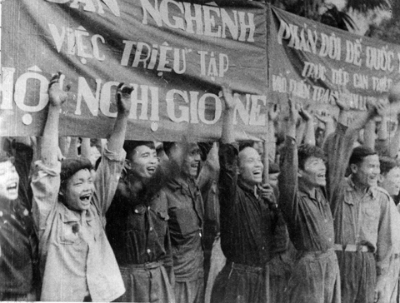
Vietnamese people rally to celebrate the convening of the Geneva Conference
The long and heroic resistance of the Vietnamese people ended in victory with the strategic offensive of the 1953-1954 Winter-Spring campaign, culminating in the Dien Bien Phu campaign, a powerful symbol of national unity and the will for independence and national reunification. On July 21, 1954, the Geneva Accords on Indochina were signed, recognizing the fundamental national rights of Vietnam, along with Laos and Cambodia, to independence, sovereignty, unity, and territorial integrity.
3. Resolutely fight against the US and the Saigon government, eliminate the division of the country, liberate the South, and unify the Fatherland.
With the signing and implementation of the Geneva Agreement, Vietnam was temporarily divided into two regions. According to this Agreement, after 2 years the French army had to withdraw from Vietnam and the Vietnamese people would hold a general election to unify the country. But the US imperialists replaced France in the South, implementing a policy of long-term division of Vietnam, turning the South into a separate, pro-American country, located in the "free world" and opposed to the "communist camp". The US and the Saigon government increasingly revealed themselves as forces that divided the nation and divided the country.
The purpose of the Vietnamese people is to fight to maintain peace.to achieve unification, complete independence and democracy throughout the country"[12].
In the early period after the Geneva Agreement was signed, the Vietnamese people persistently fought with peaceful political means to demand the implementation of the Agreement's provisions, moving towards peaceful reunification of the Fatherland. The adjustment of the regrouping and troop transfer areas was a temporary step, a transitional step to implement a ceasefire, restore peace and move towards national reunification through a free general election. The adjustment of the troop transfer areas along the 17th parallel was not to divide the country, and even less to divide the country. In that context, the Vietnam Fatherland Front was established (September 1955), issuing a Declaration calling on all classes of people, regardless of gender, age, ethnicity, social class, political orientation and religious beliefs, regardless of which side they had previously sided with, but today supported peace, unification, independence and democracy, to tighten their ranks for the cause of building and protecting the North, for the cause of peacefully fighting for national reunification.
With the will and sentiment of the North and the South being one family, the Party and the Government paid great attention to taking care of the cadres, soldiers, people and students from the South who had gathered in the North. In the fall of 1954, when hearing that the people from the South had gathered in Sam Son, Ho Chi Minh wrote a letter to inquire and encourage each person to participate in the country's construction according to their ability; at the same time, he reminded the Minister of Labor Nguyen The Tao, Head of the reception committee for the gathered forces in Sam Son: "We must, on behalf of the Party and the Government, receive them in a way that shows the love, concern and affection of the Party and the State for our fellow countrymen from the South."[13].
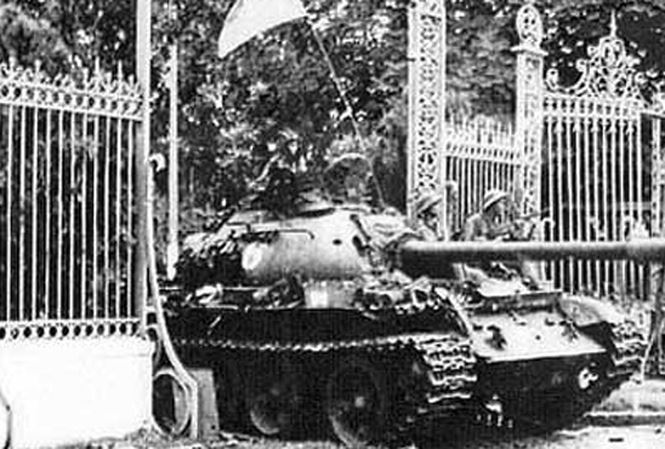
Tanks of the Vietnam People's Army crashed through the main gate of the Independence Palace on April 30, 1975.
Relying on the United States, the Saigon government avoided negotiations with the Government of the Democratic Republic of Vietnam, aiming to permanently divide Vietnam. While the people of the South intensified their peaceful political struggle, the people of the North made every effort to restore the economy and build the North into a base for the struggle to unify the country.
The North is the foundation and root of the Vietnamese revolution in the new period, so all actions in the North are aimed at strengthening the forces of both regions. The most important task of the people, the National Assembly and the Government is to strive to build socialism in the North, fight for peaceful reunification of the country and contribute to protecting peace in Southeast Asia and the world.
The 3rd Congress of the Vietnam Workers' Party (September 1960) with the policy of simultaneously implementing two revolutionary strategies in two regions, went down in history as the "Congress of building socialism in the North and fighting for national reunification".
Faced with the brutal repression of the people by the US and the Saigon government, the Central Committee of the Party decided to allow the people of South Vietnam to use revolutionary violence against the enemy's terrorist policies. In late 1959 and 1960, the Đồng Khởi (Uprising) movement erupted and spread throughout the rural areas of South Vietnam, shifting the revolution from a defensive stance to an offensive one, from partial uprisings to a full-scale revolutionary war. From the victory of the Đồng Khởi movement, on December 20, 1960, the National Liberation Front of South Vietnam was established, raising the banner of unity among all strata of the people of South Vietnam against the US and the Saigon government, striving for an independent, peaceful, democratic, and neutral South Vietnam, and ultimately achieving peaceful reunification of the Fatherland.
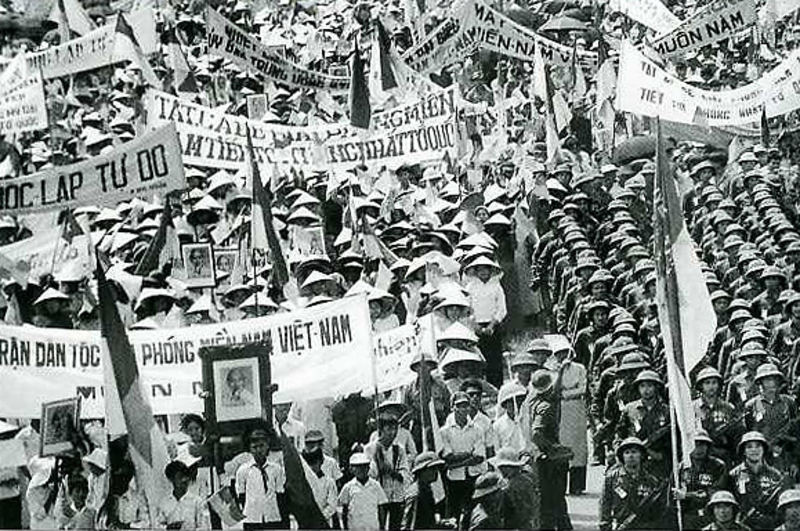
Since 1965, the US imperialists have increasingly intensified their war of aggression with the strategy of "local war" in the South and the war of destruction in the North. The Party Central Committee determined that fighting against the US to save the country was the most sacred task of the army and people in both the South and the North. The cause of liberating the South, protecting the North, and moving towards peaceful reunification of the country was the common revolutionary cause of the entire nation. The North was the great rear, the South was the great frontline, the army and people of both regions persistently promoted the cause of fighting against the US to save the country to complete victory.
“All for the sake of defeating the American invaders!”, “Not a single pound of rice is missing, not a single soldier is missing!”… are the slogans of the people of the North. On the strategic supply routes, especially the legendary Truong Son Road, the century-long struggle under the bombs and bullets of the American invaders took place day and night. All for the cause of liberating the South and unifying the country.
“Holding the enemy’s belt and fighting”, the Southern army and people heroically developed an offensive strategy by combining political struggle with armed struggle; combining three prongs of attack: military, political and military agitation; combining three strategic areas: rural mountains, rural plains and urban areas, determined to “Fight to drive the Americans out, fight to topple the puppets”.
While the nation's anti-American war for national salvation was taking place fiercely, President Ho Chi Minh passed away, leaving in his Will his last wish: "Our entire Party and people unite to strive to build a peaceful, unified, independent, democratic and prosperous Vietnam, and make a worthy contribution to the world revolutionary cause." Ho Chi Minh advised to "prepare everything to unify the country", emphasizing the extremely important task that must be done immediately after the victory of the resistance.
The army and people of the whole country fought bravely with the oath: "Forever uphold the flag of national independence, determined to fight and defeat the American invaders, liberate the South, protect the North, unify the country to satisfy His wish."[14].
After heavy defeats in both the North and South, the US was forced to de-escalate the war, enter into negotiations and sign the Paris Agreement (January 27, 1973), recognizing the basic national rights of Vietnam: independence, sovereignty, unity and territorial integrity. But the US and the Saigon government sabotaged the Agreement, the Vietnamese people had to continue to fight. It was a fierce confrontation between peace and war, between justice and brutality, between national independence and national unity and national division and division of the country.
With the 1975 Spring General Offensive and Uprising, culminating in the historic Ho Chi Minh Campaign, the Vietnamese army and people ended the more than century-long march against colonialism, washed away the humiliation of losing the country, eliminated the disaster of national division, reunited the country, and opened an era of national independence, unity, and socialism.
[1]Ho Chi Minh City:Complete Collection, National Political Publishing House, Hanoi, 2011, Vol. 4, p. 1.
[2]Ho Chi Minh City:Complete Collection, Ibid, vol. 3, p. 256.
[3]Ho Chi Minh City:Complete Collection, Ibid., Vol. 9, p. 35.
[4]On August 17, 1945, as the flames of the national uprising in Vietnam were burning, De Gaulle convened the French Defense Committee to draw up the "Plan for the Liberation of Indochina," deciding to reorganize the French military command in Indochina, appointing Admiral Thierry D'Argenlieu as High Commissioner with the directive: "The High Commissioner's first mission is to restore French sovereignty over the territories of the Indochinese Federation," and General Leclerc as Supreme Commander of the French expeditionary forces in the Far East with the task of "implementing all necessary military measures to restore sovereignty there" (Devillers Phillipe (1993).Paris - Saigon - Hanoi, Archives of the 1944-1947 war(General Publishing House, Ho Chi Minh City, p. 131).
[5]Ho Chi Minh City:Complete Collection, Ssdd, vol. 4, pp. 202-203.
[6]Ho Chi Minh City:Complete Collection, Ibid., Vol. 9, p. 36.
[7]Ho Chi Minh City:Complete Collection, Ibid, vol. 4, p. 280.
[8]Ho Chi Minh City:Complete Collection, Ibid., vol. 4, pp. 327-328.
[9]Ho Chi Minh City:Complete Collection, Ibid., Vol. 4, p. 468.
[10]Ho Chi Minh City:Complete Collection, Ibid, vol. 4, p. 478.
[11]Ho Chi Minh City:Complete Collection, ibid., vol. 4, p. 522.
[12]Ho Chi Minh City:Complete Collection, Ibid, vol. 9, p. 37.
[13] Southern Students – Then and Now, National Political Publishing House, Hanoi, 2000, p. 15.
[14]Communist Party of Vietnam:Complete Party Documents, National Political Publishing House, Hanoi, 2004, vol. 30, p. 276.
Author:Associate Professor, Dr. Vu Quang Hien
Newer news
Older news